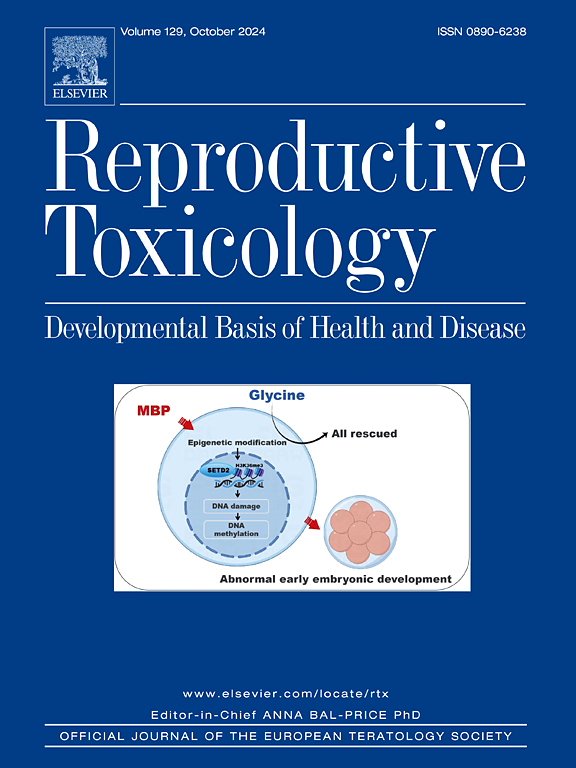饮食摄入PCDD/Fs估计水平与人类精子质量之间的关系。
IF 3.3
4区 医学
Q2 REPRODUCTIVE BIOLOGY
引用次数: 0
摘要
本研究旨在探讨多氯二苯并对二恶英(PCDDs)和多氯二苯并呋喃(PCDFs)的估计膳食摄入量与人类精子质量之间的关系。本研究横断面评估了200名年龄在18-40岁的铅-铁研究参与者中PCDD/Fs的估计饮食摄入量与精子质量参数之间的关系。考虑潜在混杂变量的线性回归模型被用来评估这些关系。为了估计PCDD/Fs暴露,使用了食物频率问卷和食品中PCDD/Fs浓度的最新数据,这些数据主要来自西班牙。我们的研究结果表明,与最低分位的参与者相比,最高分位(T3)饮食摄入PCDD/Fs的参与者表现出显著的体重指数升高,肉、鱼和蛋的消费量增加,坚果的消费量减少。此外,T3组的个体显示出更高的精子头畸形百分比(4.65% [0.10;9.24);p-trend= 0.037),每增加1 sd,能量调整后的总PCDD/Fs日粮摄入量相应增加(1.84% [0.38;3.68])。没有发现其他精子参数的显著关联。关于PCDD/F饮食暴露与人类精子质量的研究很少。这项研究表明,较高的PCDD/Fs摄入量与精子头部异常百分比之间存在显著的直接关联,这可能会损害人类生殖健康。本文章由计算机程序翻译,如有差异,请以英文原文为准。
Association between dietary intake estimated levels of PCDD/Fs and human sperm quality
This study aimed to investigate the association between estimated dietary intake of polychlorinated dibenzo-p-dioxins (PCDDs) and polychlorinated dibenzofurans (PCDFs) and human sperm quality. This study cross-sectionally assessed the associations between estimated dietary intake of PCDD/Fs and sperm quality parameters in 200 participants aged 18–40 years from the Led-Fertyl study. Linear regression models, accounting for potential confounding variables, were employed to evaluate the relationships. To estimate the PCDD/Fs exposure, food frequency questionnaires and the latest data on PCDD/Fs concentrations in food, primarily from Spanish sources, were used. Our findings indicate that, in comparison to participants in the lowest tertile, those in the highest tertile (T3) of PCDD/Fs dietary intake exhibited significantly elevated body mass index, increased consumption of meat, fish and eggs, and decreased consumption of nuts. Furthermore, individuals in T3 demonstrated a higher percentage of sperm head abnormalities (4.65 % [0.10; 9.24]; p-trend= 0.037) and a corresponding increase per 1-SD increment in energy-adjusted total PCDD/Fs dietary intake (1.84 % [0.38; 3.68]). No significant associations for other sperm parameters were found. Minimal research exists on PCDD/F dietary exposure and human sperm quality. This study shows significant direct association between higher PCDD/Fs intake and the percentage of sperm head abnormalities which potentially may compromise human reproductive health.
求助全文
通过发布文献求助,成功后即可免费获取论文全文。
去求助
来源期刊

Reproductive toxicology
生物-毒理学
CiteScore
6.50
自引率
3.00%
发文量
131
审稿时长
45 days
期刊介绍:
Drawing from a large number of disciplines, Reproductive Toxicology publishes timely, original research on the influence of chemical and physical agents on reproduction. Written by and for obstetricians, pediatricians, embryologists, teratologists, geneticists, toxicologists, andrologists, and others interested in detecting potential reproductive hazards, the journal is a forum for communication among researchers and practitioners. Articles focus on the application of in vitro, animal and clinical research to the practice of clinical medicine.
All aspects of reproduction are within the scope of Reproductive Toxicology, including the formation and maturation of male and female gametes, sexual function, the events surrounding the fusion of gametes and the development of the fertilized ovum, nourishment and transport of the conceptus within the genital tract, implantation, embryogenesis, intrauterine growth, placentation and placental function, parturition, lactation and neonatal survival. Adverse reproductive effects in males will be considered as significant as adverse effects occurring in females. To provide a balanced presentation of approaches, equal emphasis will be given to clinical and animal or in vitro work. Typical end points that will be studied by contributors include infertility, sexual dysfunction, spontaneous abortion, malformations, abnormal histogenesis, stillbirth, intrauterine growth retardation, prematurity, behavioral abnormalities, and perinatal mortality.
 求助内容:
求助内容: 应助结果提醒方式:
应助结果提醒方式:


